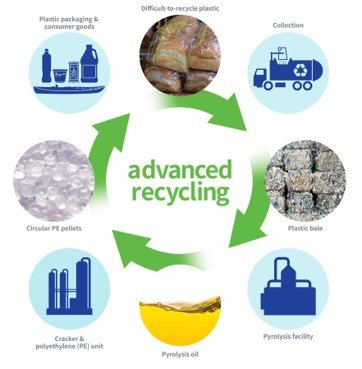Recycling the Impossible
By Abby Mastromonaco and Jacob Humphrey
WHAT IS RECYCLING?
By definition, recycling is the process of converting waste materials into new products. Plastics are collected from the curb by waste management services, and then brought to Material Recovery Facilities (MRF). The plastic then goes through sorting, washing, processing, shredding, melting, and ends up as plastic pellets.
For a more detailed description into the workings of recycling, read this article by the United States Environmental Protection Agency.
Check out this game to try the sorting process for yourself!
Even though consumers are putting out a higher percentage of plastics for recycling, approximately half of the plastic collected at the curb doesn’t make its way to the facility. The reason most likely is that the collected recycling contains a type of plastic for which there is no way to recycle even though it is labeled with a recycling symbol. (Tolinski and Carlin 57)
THE PROBLEM
The recycling stamps on plastic products were the idea of plastics lobbyists who wanted to improve the reputation of plastics. In the 1980s before we depended on plastics as much as we do today, people saw how much waste was being generated and considered switching away from plastic products as the reputation of the material deteriorated. This would devastate plastics production companies, so they, along with the lobbyists, came up with a solution to positively influence consumers’ views on the products. (Gonzales and Sullivan)
In addition to advertising campaigns that cost up to $50 Million a year, they began stamping plastic products with the recycling symbol since, in theory, plastics can be recycled. They hoped that if people thought the material could be recycled, they wouldn’t be so opposed to it. Environmentalists supported this decision as well, because stamping the plastic with the symbol and number would improve sorting processes.
The problem was, not all plastics can, or should, be recycled. Economically it doesn’t always make sense, it’s chemically problematic and time consuming. Additionally, plastic degrades every time it gets reused, so its value diminishes each time it gets recycled. The oil and plastics industry has known for 50 years that plastic recycling wasn’t going to work as they claimed it would.
1990s Plastics greenwashing advertisement
1990s Plastics greenwashing advertisement
IMPROVEMENTS
Improvements to the recycling process are just as important to learn about. When consumers are aware that change is positively affecting the system, they will feel more inspired to participate. The recycling process could finally be improved for good.
Company Involvement
Plastic production companies such as Chevron Phillips are investing into plastics recycling, and ultimately the future of plastics. Chevron Phillips’ vice president of sustainability, Jim Becker, revealed a bold pledge made by the company. According to Jim, Chevron Phillips plans to recycle 100% of the plastic they make by 2040. While the current rate of plastics recycling is at 9%, 100% in less than 20 years is more than a bold statement.
To hear about Chevron Phillips’ pledge, check out NPR’s Planet Money
Clear Instructions
One way companies and brands are improving recycling is by adding new labels on heterogeneous-materialed products. This helps inform the consumer of the recyclability of the product.
Innovation and Technology
Technology is improving the sorting process. Companies are creating Artificial Intelligence (AI) to sort different materials. The machine learns the shapes, colors, and chemical makeup of each different material. Once this innovation is fully developed, it will likely improve recycling rates and overall accuracy.
To learn more about AI sorting, check out GreyParrot’s website.
Remove Ambiguity
The industry has been working on changing the misleading recycling symbols on plastic products. This code system is now in the hands of the American Society for Testing and Materials, ASTM. In 2010, the ATSM changed the symbol from the familiar “chasing arrows” indicator of recycling to a solid triangle. This is only applicable for plastics molds made after the change, which is why the chasing arrows symbol is still in circulation. While this new symbol is still ambiguous as it resembles the old recycling symbol, it is a step in the right direction.
You don’t have to be a company to help improve the recycling process! Here are some improvements that can be made from home
Conclusion
The plastics recycling process is extremely complex, and has not always worked as we may have once thought it did. However, with increased technology and improved consumer education, rising recycling rates could be on the horizon.
By reading this, you are joining the movement in helping to improve recycling for good.
References
Tolinski, Michael, and Conor P. Carlin. Plastics and Sustainability Grey Is the New Green: Exploring the Nuances and Complexities of Modern Plastics. Wiley, 2021.
Sullivan, Laura. “How Big Oil Misled The Public Into Believing Plastic Would Be Recycled.”, NPR, 11 Sept. 2020, https://www.npr.org/2020/09/11/897692090/how-big-oil-misled-the-public-into-believing-plastic-would-be-recycled
Sullivan, Laura, and Sarah Gomez. “Planet Money – Waste Land.” NPR, 11 Sept. 2020, https://www.npr.org/2020/09/11/912150085/waste-land







